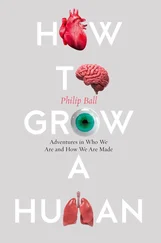17 | In the outer reaches of the universe, as far away from here as it is possible to be, beyond time and space and meaning and matter, nothing was happening. And the nothing was without form, pure potential for becoming, an evanescent yet heaving sea of energy coming into and out of existence. For reasons not yet understood, a bubble of energy that should have burst back into non-existence breaks free with the rage of Achilles from the conditions of the quantum world and sweeps out a universe.
18 | The universe is just one of those things that happens from time to time. Everything that is exists only by happenstance, randomly, out of nothing.
19 | If less is more, is nothing too much?
20 | For now the most widely-agreed-on model that describes how the universe got going is the theory of eternal inflation. An infinite number of ‘bubbles’ arose in an eternally inflating quantum landscape. One of these bubbles became the island universe we call home. An infinite number of other island universes exist in all the possible forms determined by some constraining mathematical model, most popularly string theory. 5The landscape out of which these island universes emerged is called the multiverse.
21 | Inflation is happening eternally, elsewhere. Our ‘island’ universe inflated briefly. It doubled in size every 10 –34seconds. After about a hundred such doublings it had grown to about the size of a grapefruit, at which point the period of inflation came to an end. 6Why inflation came to an end locally is not yet known.
I could be bounded in a nutshell, and count myself king of infinite space.
Shakespeare (1564–1616), Hamlet
22 | i You do not need God in order to create a universe, says Stephen Hawking. All you need is gravity, quantum electrodynamics, special and general relativity, M-theory and a few other bits and pieces of physics. But where these ingredients come from remains, for the moment at least, an unanswered question.
ii M-theory (no one can remember what the M stands for) is a formulation of string theory, and a quantum theory of gravity – an abstract and mathematical theory, as yet without physical proof. M-theory describes a multiverse of eleven dimensions in which there may be many island universes like ours, adrift in four dimensions of time and space; and many other kinds of universes adrift in different numbers of dimensions of space, some perhaps with several dimensions of time (whatever that might look like). M-theory describes 10 500different universes.
Consider the most obvious question of all about the initial state of the universe. Why is there an initial state at all?
Lawrence Sklar, philosopher of physics
The desire to find a beginning comes from the idea that everything has the real, solid existence that our minds generally perceive.
Matthieu Ricard and Trinh Xuan Thuan, The Quantum and the Lotus
As far as I can see, such a theory [as the Big Bang] remains entirely outside any metaphysical or religious question. It leaves the materialist free to deny any transcendental Being … For the believer, it removes any attempt at familiarity with God. It is consonant with Isaiah speaking of the hidden God, hidden even in the beginning of the Universe.
Georges Lemaître
23 | In saying that the universe randomly evolved out of some initial energy condition that we don’t yet fully understand, we sweep everything we don’t know about the universe under the carpet. All the unanswered questions about the physical universe get pushed to its horizons, far away from where humans are. The horizons of the universe are the limits of what we can see and what we can understand. The universe disappears over its own horizon, taking with it the laws of nature, forever just out of our reach. For a while, the more we found out about the physical universe the larger it became. But largeness itself has become passé . The universe shows itself to be subtler than mere size. All our creative speculations, even when they harden into theories, merely push the mystery of what we are and where we come from to ever more distant regions of an ever more elusive universe.
SECTION 5
What is science?
Science (a term in itself inoffensive and of indefinite meaning).
Joseph Conrad (1857–1924), The Secret Agent
That bright-eyed superstition known as infinite human progression.
Terry Eagleton, literary theorist and critic
1 | Life may be messy, but in the physical world there appears to be underlying order. Evidence of this order has encouraged scientists to believe in the existence of physical laws of nature. Why nature should have unifying features is a deep mystery. That physical laws of nature are ultimately reducible to mathematics is an even deeper mystery. 1
2 | The difference between the ways of science and the ways of other truth-seeking enterprises is that science has a method.
First find what you think might be a solution to a problem, then express it as a mathematical model, then test it.
David Deutsch, physicist
3 | In science, to look is not enough, there needs also to be intervention in order to affirm what it is that is being looked at. A testable theory is required, not just mere description, though a description is a start. A theory is proven for as long as it is confirmed in that repeatable process of measurement called experiment. Sometimes we improve our ability to measure and theories are further confirmed, and sometimes theories fail when examined more closely.
If the explanation of physical phenomena were evident in their appearance, empiricism would be true and there would be no need for science as we know it.
David Deutsch
‘We admit the existence of electricity, which we know othing about, why can’t there be a new force, still unknown which …’
‘When electricity was found,’ Levin quietly interrupted, ‘it was merely the discovery of a phenomenon, and it was not known where it came from or what it could do, and centuries passed before people thought of using it. The spiritualists on the contrary, began by saying that tables write to them, and spirits come to them, and only afterwards started saying it was an unknown force.’
Vronsky listened attentively to Levin, as he always listened, evidently interested in his words.
‘Yes, but the spiritualists say: now we don’t know what this force is, but the force exists, and these are the conditions under which it acts. Let the scientist find out what constitutes this force. No, I don’t see why it can’t be a force, if it …’
‘Because,’ Levin interrupted again, ‘with electricity, each time you rub resin against wool, a certain phenomenon manifests itself, while here it’s not the same each time, and therefore it’s not a natural phenomenon.’
…
‘I think,’ he continued, ‘that this attempt by spiritualists to explain their wonder by some new force is a most unfortunate one. They speak directly about spiritual force and want to subject it to material experiment.’
They were all waiting for him to finish, and he felt it.
‘And I think that you’d make an excellent medium,’ said Countess Nordston, ‘there’s something ecstatic in you.’
Leo Tolstoy, Anna Karenina
4 | The astronomer Nicolaus Copernicus (1473–1543) wondered if there might be some sort of inclination in matter that causes matter to be drawn to itself. But his was a vague poetic notion; it didn’t have what elevates Newton’s description – of what was later named gravity – to the level of theory. Newton writes in mathematics how the force works even as he fails to tell us what it is. Since it acts at a distance without any visible means of action, Newton’s gravity has no material existence, for which lack the theory was criticised by followers of Descartes, who believed that physical actions must result only from physical causes. But in physics mathematics trumps material means. The theory works, and that is enough, particularly when the theory is as encompassing as this one: explaining as it does both why an apple falls to earth and why the earth falls perpetually towards the sun.
Читать дальше












